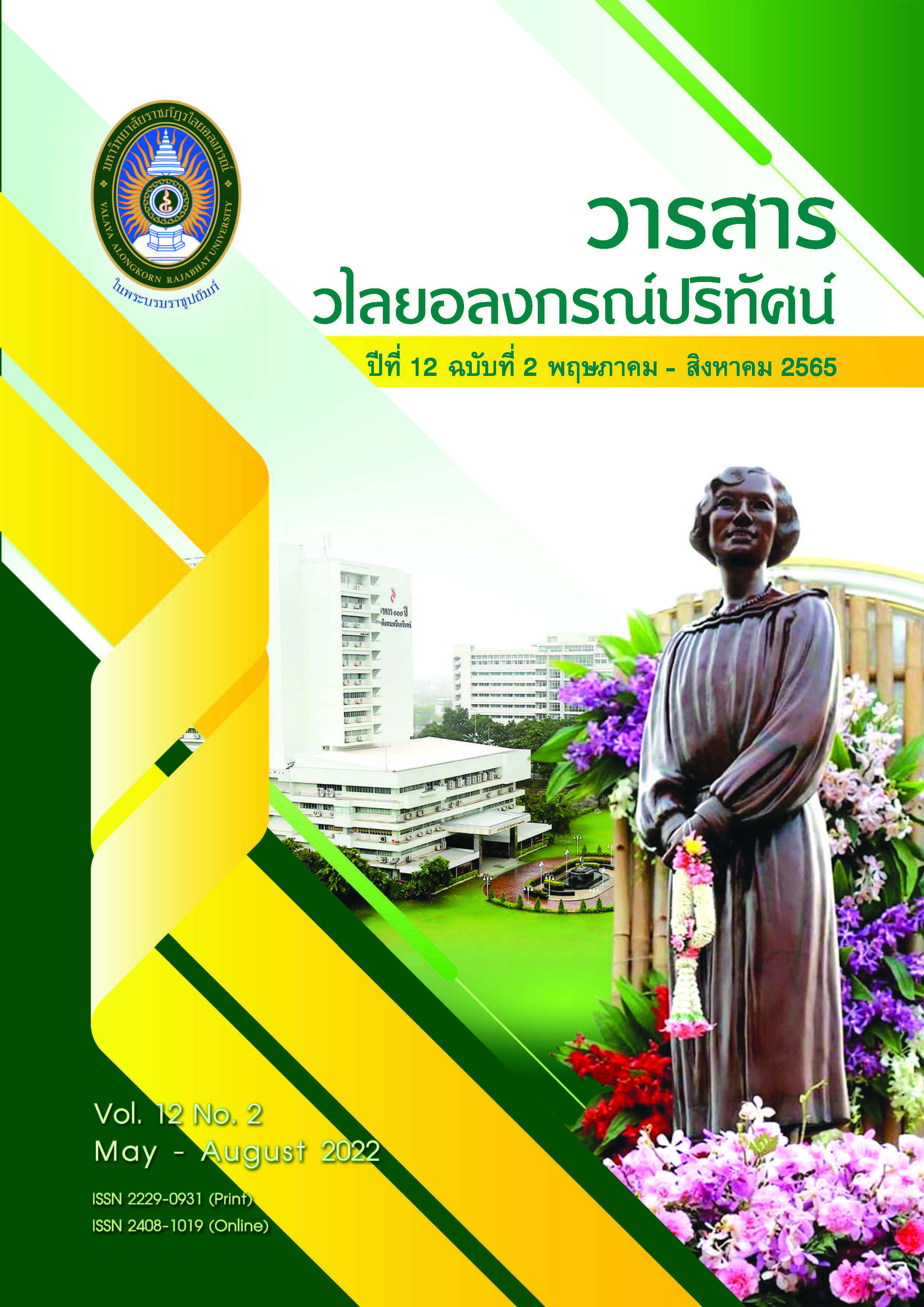ผลการจัดกิจกรรมการเรียนรู้โดยใช้กระบวนการคิดเชิงออกแบบ สำหรับสร้างนวัตกรรมในการรับมือการแพร่ระบาดของโรคโควิด-19 เพื่อส่งเสริมความเป็นพลเมือง สำหรับนักเรียนชั้นมัธยมศึกษาปีที่ 6
คำสำคัญ:
การจัดกิจกรรมการเรียนรู้, กระบวนการคิดเชิงออกแบบ, ความเป็นพลเมืองบทคัดย่อ
การวิจัยครั้งนี้จึงมีวัตถุประสงค์เพื่อศึกษาความเป็นพลเมืองและศึกษาทักษะการสร้างสรรค์และนวัตกรรม หลังเรียนด้วยกิจกรรมการเรียนรู้โดยใช้กระบวนการคิดเชิงออกแบบสำหรับสร้างนวัตกรรมในการรับมือการแพร่ระบาดของโรคโควิด-19 กลุ่มตัวอย่าง คือ นักเรียนชั้นมัธยมศึกษาปีที่ 6 ห้องเรียนที่ 6/1 จำนวน 31 คน ภาคเรียนที่ 2 ปีการศึกษา 2564 โรงเรียน วิทยานุกูลนารี สำนักงานเขตพื้นที่การศึกษามัธยมศึกษาเพชรบูรณ์ ซึ่งได้มาโดยการสุ่มแบบ แบ่งกลุ่ม เครื่องมือที่ใช้ในการวิจัย 1) แบบสอบถามความเป็นพลเมืองในการสร้างนวัตกรรมรับมือ การแพร่ระบาดของโรคโควิด-19 2) แบบสัมภาษณ์ความเป็นพลเมืองในการสร้างนวัตกรรมรับมือ การแพร่ระบาดของโรคโควิด-19 และ 3) แบบประเมินทักษะการสร้างสรรค์และนวัตกรรมในการรับมือการแพร่ระบาดของโรคโควิด-19 การหาคุณภาพเครื่องมือมีค่าดัชนีความสอดคล้องอยู่ระหว่าง 0.67-1.00 ค่าความสัมพันธ์ระหว่างคะแนนรายข้อกับคะแนนรวม อยู่ระหว่าง 0.35-0.85 และมีค่าความเชื่อมั่นของแบบสอบถามทั้งฉบับ เท่ากับ 0.94 วิเคราะห์ข้อมูลเชิงปริมาณ ด้วยการใช้สถิติ ค่าเฉลี่ย ส่วนเบี่ยงเบนมาตรฐาน ร้อยละ และวิเคราะห์ข้อมูลเชิงคุณภาพ ด้วยการวิเคราะห์เนื้อหา
ผลการวิจัยพบว่า 1) นักเรียนมีความเป็นพลเมือง ภาพรวมอยู่ในระดับมาก ด้านความผูกพัน ความมุ่งมั่น ความทุ่มเทในกิจการสาธารณะของชุมชน อยู่ในอันดับสูงสุด ด้านการเป็นสมาชิกในชุมชน อยู่ในอันดับต่ำสุด และนักเรียนมีการสร้างความคิด เกิดความตระหนัก เห็นคุณค่าการทำกิจกรรมร่วมกันของคนในชุมชน และ 2) นักเรียนมีทักษะการสร้างสรรค์และนวัตกรรม ภาพรวมอยู่ในระดับดีมาก ด้านการสร้างความคิด อยู่ในอันดับสูงสุด และด้านการผลิตและสร้างนวัตกรรมอย่างสร้างสรรค์ อยู่ในอันดับต่ำสุด
เอกสารอ้างอิง
ชนิกานต์ กลิ่นอาจ. (2563). วิจัยเชิงปฏิบัติการเพื่อพัฒนาความสามารถในการสร้างสรรค์และนวัตกรรมของนักเรียนชั้นมัธยมศึกษาปีที่ 5 ด้วยการจัดการเรียนรู้ตามกระบวนการคิดเชิงออกแบบ เรื่อง เคมีไฟฟ้า. การค้นคว้าอิสระ ปริญญาการศึกษามหาบัณฑิต สาขาวิชาวิทยาศาสตร์ศึกษา มหาวิทยาลัยนเรศวร.
ทิศนา แขมมณี. (2545). ศาสตร์การสอน องค์ความรู้เพื่อการจัดกระบวนการเรียนรู้ ที่มีประสิทธิภาพ. กรุงเทพฯ: สำนักพิมพ์จุฬาลงกรณ์มหาวิทยาลัย.
มูลนิธิเพื่อคนไทย. (2557). “Active Citizenship” พลเมืองที่มีส่วนร่วมเพื่อส่วนรวม เปลี่ยนประเทศไทยได้ด้วยตัวเรา. [ออนไลน์], เข้าถึงได้จาก: http://khonthaifoundation.org/th/active-citizenship (2564, 1 สิงหาคม).
รจเรข อุ่นตาล. (2559). การเสริมสร้างความเป็นพลเมืองเข้มแข็งในภาคประชาสังคม. ปริญญาศิลปศาสตรมหาบัณฑิต การบริหารและพัฒนาสังคม มหาวิทยาลัยเกษตรศาสตร์.
วิจารณ์ วานิช. (2555). วิถีสร้างการเรียนรู้เพื่อศิษย์ ในศตวรรษที่ 21. กรุงเทพฯ:
มูลนิธิสดศรีสฤษดิ์วงศ์.
ศิริพันธุ์ ศิริพันธุ์ และยุพาวรรณ ศรีสวัสดิ์. (2554). การจัดการเรียนการสอนที่เน้นผู้เรียนเป็นสำคัญ: วิธีการสอนแบบใช้ปัญหาเป็นหลัก. วารสารมหาวิทยาลัยนราธิวาสราชนครินทร์. 3(1), 104-112.
สมโภชน์ พูลเขตกิจ. (2563). การพัฒนากิจกรรมการเรียนรู้โดยใช้แนวคิดเชิงออกแบบ เพื่อเสริมสร้างทักษะด้านการสร้างสรรค์และนวัตกรรม สำหรับนักเรียนชั้นมัธยมศึกษาปีที่ 6. การค้นคว้าอิสระปริญญาการศึกษามหาบัณฑิต สาขาวิชาหลักสูตรและการสอนมหาวิทยาลัยนเรศวร.
สำนักงานกองทุนสนับสนุนการเสริมสร้างสุขภาพ. (2563). แนะหลัก 4 ต. สู้โควิด-19. [ออนไลน์], เข้าถึงได้จาก: https://www.thaihealth.or.th (2564, 6 สิงหาคม).
สำนักงานปลัดกระทรวงศึกษาธิการ. (2560). การศึกษาความเป็นพลเมืองของผู้เรียน ในสถานศึกษา สังกัดกระทรวงศึกษาธิการ. [ออนไลน์], เข้าถึงได้จาก: http://www.bps.moe.go.th (2564, 31 สิงหาคม).
สำนักงานเลขาธิการสภาการศึกษา. (2560). แผนการศึกษาแห่งชาติ พ.ศ. 2560-2579. กรุงเทพฯ: พริกหวานกราฟฟิค.
องค์การยูนิเซฟ ประเทศไทย ร่วมกับสำนักงานปลัดกระทรวงศึกษาธิการและสำนักงานคณะกรรมการการศึกษาขั้นพื้นฐาน กระทรวงศึกษาธิการ. (2563). คู่มือสำหรับการจัดกิจกรรมส่งเสริมการเรียนรู้เกี่ยวกับโรคโควิด-19. กรุงเทพฯ: กองทุนเพื่อความเสมอภาคทางการศึกษา.
Laurel Cadwallader Stolte, Molly Isenbarger, & Alison Klebanoff Cohen. (2014). Measuring Civic Engagement Processes and Youth Civic Empowerment in the Classroom: The CIVVICS Observation Tool. The Clearing House, 44-51.
Michael, L., Patrick, L., & Larry, L. (2020). The Design Thinking Toolbox. New Jersey: John Wiley & Sons.
OECD. (2020). Coronavirus special edition: Back to school. [Online], Available: http://www.oecd.org/economy/poland-economic-forecast-summary.htm. (2021, 2 August).
Papa, V. & Milioni, D. L. (2013). “Active Citizenship or Activist Citizenship? A Framework for Studying Citizenship in New Social Movements and the Role of ICTs.” Journal of the MeCCSA-PGN, 6(3): 30-34.
Stanford Design School. (2005). Bootcamp Bootleg. [Online], Available: https://dschool.stanford.edu/fellows-in-residence/project-fellowship-history- approach. (2021, 28 July).
ดาวน์โหลด
เผยแพร่แล้ว
รูปแบบการอ้างอิง
ฉบับ
ประเภทบทความ
สัญญาอนุญาต
ลิขสิทธิ์ (c) 2022 สุภรัตน์ เกศณรายณ์, จักรกฤษณ์ จันทะคุณ

อนุญาตภายใต้เงื่อนไข Creative Commons Attribution-NonCommercial-NoDerivatives 4.0 International License.
ข้อความที่ปรากฏในบทความแต่ละเรื่องในวารสารวไลยอลงกรณ์ปริทัศน์ เป็นความคิดเห็นของผู้นิพนธ์แต่ละท่าน มิใช่เป็นทัศนะและมิใช่ความรับผิดชอบของกองบรรณาธิการจัดทำวารสาร และ
มหาวิทยาลัยราชภัฏวไลยอลงกรณ์ ในพระบรมราชูปถัมภ์


